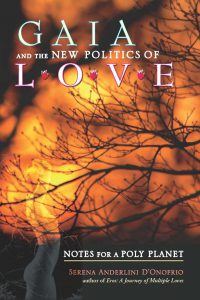Dear Earthlings:
The EcoSex course at U Conn is in process. It’s a great experience. We are reading amazing books. Thinking out of the box and across disciplines. Students are sending their responses in, with discussion questions. In class, we connect the dots: a holograph of what we’ve read together, the “required readings.” Multiple perspectives and good synergy. Here, we offer a glimpse. Lynn Margulis and Dorion Sagan’s Symbiotic Planet was one of two theory-of-science books. We got three responses: from Alexandra, John, and Adam.
Here’s John‘s take:
I’m horribly science illiterate. It was hard for me to focus on passages like this:
 No one claims to have “solved” the origin of life problem. Yet although we cannot create cells from chemicals, cell-like membranous enclosures form as naturally as bubbles when oil is shaken with water. In the earliest days of the still life-less Earth, such bubble enclosures separated inside from outside. As Harold J. Morowitz, distinguished professor at George Mason University, Fairfax, Virginia, and director of the Krasnow Institute for the Study of Evolution of Consciousness, argues in his amusing mayonnaise book, we think that prolife, with a suitable source of energy inside a greasy membrane, grew chemically complex. These lipidic bags grew and developed self-maintenance. They, through exchange of parts, maintained their structure in a more or less increasingly faithful way. Energy, of course, was required. Probably solar energy at first moved through the droplets; controlled energy flow led to the selfhood that became cell life. By definition, the most stable of these droplets survived longest and eventually, at random, retained their form by incessant interchange of parts with the environment. After a great deal of metabolic evolution, which I believe occurred inside the self-maintaining greasy membrane, some, those containing phosphate and nucleotides with phosphate attached to them, acquired the ability to replicate more or less accurately. (71-2)
No one claims to have “solved” the origin of life problem. Yet although we cannot create cells from chemicals, cell-like membranous enclosures form as naturally as bubbles when oil is shaken with water. In the earliest days of the still life-less Earth, such bubble enclosures separated inside from outside. As Harold J. Morowitz, distinguished professor at George Mason University, Fairfax, Virginia, and director of the Krasnow Institute for the Study of Evolution of Consciousness, argues in his amusing mayonnaise book, we think that prolife, with a suitable source of energy inside a greasy membrane, grew chemically complex. These lipidic bags grew and developed self-maintenance. They, through exchange of parts, maintained their structure in a more or less increasingly faithful way. Energy, of course, was required. Probably solar energy at first moved through the droplets; controlled energy flow led to the selfhood that became cell life. By definition, the most stable of these droplets survived longest and eventually, at random, retained their form by incessant interchange of parts with the environment. After a great deal of metabolic evolution, which I believe occurred inside the self-maintaining greasy membrane, some, those containing phosphate and nucleotides with phosphate attached to them, acquired the ability to replicate more or less accurately. (71-2)
I have the vaguest idea of what any of that means. And there were at least two solid chapters that went pretty much like that.
That said, I really do love the general philosophy of the book Margulis outlined in the beginning and ending chapters. The thing is, I feel kind of gripped. Gaia Theory is beautiful, but it’s hardly unique. Margulis struggles to really define the theory outside of the context of the personified goddess “Gaia” but not so clinically in the field of science. Even though it’s a poetic and beautiful description, Margulis “regrets” the personification of Gaia because “many scientists are still hostile to Gaia, both the word and the idea,” (118). I suppose this is probably a mistake because by choosing the name of a being that has a distinct personality and mythology attached, the movement became personified. It’s impossible to think of “Marxism” without reference to Marx, though his ideas are far from unique.
This is why, when I initially heard the term “Gaia” I was also a little skeptical of it. Things are so Eurocentric already, why not K’un Theory? The Chinese ba gua (see below) is a model of the universe. It associates (among many other things) north, winter, earth, receptive, and mother energies under the same symbol (seen at the direct bottom of the diagram):
Unlike Gaia, there is no personal connotation ascribed to K’un. It is a force, an energy, not a deity. This seems like the sort of thing Margulis wishes could come across in Gaia Theory because she, “cannot stress strongly enough that Gaia is not a single organism. My Gaia is no vague, quaint notion of a mother Earth who nurtures us,” (123).
The Ecosexual movement could profit greatly from infusion of Eastern thought and philosophy. Referring to sex as more than just the act of copulation, sex has a special place in a lot of Eastern systems of thought. Tibetan mythology contains a symbol called yab-yum (lit. father-mother) which shows a male deity in sexual union with a female consort. The male deity represents compassion, while the female partner wisdom. It’s a rather common tantric symbol, but it doesn’t just look at sex as sin or a matter of procreation (as contemporary Christianity does, and science seems to be a simultaneous extension and reaction toward). Here, sex is the universe. Margulis seems to come very close to this opinion on page 103, “Sex, like symbiosis, is a matter of merging. But it is also a matter of periodic escape from the merger… cell symbiosis is a deeper, more permanent and unique level of fusion. In the great cell symbioses, those of evolutionary moment that led to organelles, the act of mating is, for all practical purposes, forever.”
This reminds me of Osamu Tezuka’s biography of the Buddha. As a monk in the Forest of Uruvela, Siddhartha meditated and was visited by a young girl Sujata. Gradually, Sujata fell in love with Siddhartha but since Siddhartha was not only already married, but was also on a path to enlightenment, he refused to marry or sleep with Sujata. Since she couldn’t handle unrequited love, Sujata allowed a poisonous snake to bite her. Sujata’s father found Siddhartha and demanded that he heal his daughter. Not knowing medicinal arts, Siddhartha was once told he had psychic powers to use. He entered Sujata’s mind to bring her soul back from the brink of death and instead was greeted on the edge of reality:
The Brahma: Now look around, Siddhartha. These are all pieces of life.
Siddhartha: Pieces of life…?
The Brahma: Mm-hmm. And that huge ball is the universe.
Siddhartha: Universe? And what’s the universe?
The Brahma: All of heaven and earth.
Siddhartha: But that thing is moving… it’s always changing shape…
The Brahma: Indeed. The universe is alive.
(Buddha 4: The Fores of Uruvela, 210-1)
I guess this is why Gaia Theory doesn’t shock me or isn’t particularly hard to understand: because Buddhists have been aware of this concept for 2,500 years. Looking at Deborah Anapol’s Seven Natural Laws and Margulis’ SET theory, it reminds me of how to put it into practice in the finale of Tezuka’s biography of the Buddha:
If you are rich, you can give to those who suffer. If you are strong, you can support those who suffer. If you are neither rich nor strong, you can listen to them and offer your sympathy, telling them you are sorry. That is good enough… [for] you will have suffered for another. Let us call this spirit ‘mercy’… Mercy! It resides in every human soul. That is why, when you show pity to someone who is suffering, another will show you pity when your day has come to suffer. If you help someone, believe me, another will help you someday because we are all connected to each other, every living thing.
(Buddha 8: Jetavana, 320-2)
If we replace “mercy” with “love,” I think the quote still works for the Ecosexual movement.
Questions for Discussion:
1. How does the science promote (or does it just confuse) the social movement?
2. Should the social and cultural aspects be separated from the science?
3. Can they?
John Nitowski
Published with permission
WGSS 3998 – Ecosexuality and the Ecology of Love
Prof. Serena Anderlini-D’Onofrio
U Conn, Storrs, Spring 2013
Dear Earthlings:
Let “nature” be your teacher in the arts of love. Education is the heart of democracy, education to love. Come back for more wonders: Students Responses to appear every Tuesday. Book Reports scheduled every other Thursday. Check out our summer offerings: Ecosexuality in Portland, OR, July 17-21. Info and Registration here!
Namaste,
Serena Anderlini-D’Onofrio, PhD
Gilf Gaia Extraordinaire
Author of Gaia, Eros, and many other books about love
Professor of Humanities
University of Puerto Rico, Mayaguez
Follow us in the social media
Author’s Page/Lists all books:





http://polyplanet.blogspot.com
 Another quote that resonated strongly with me (I have no objections to it, just an observation) is when American foreign policy is compared to allopathic medicinal approach, “The United States is the body, the Twin Towers one of its vital organs,” (78). I hold the pretty unpopular opinion that the United States brought 9/11 upon itself. This is usually taken to mean that I think the United States (and the victims of that day) “deserve” what they got. I don’t mean this in the slightest, but rather that because of American interference in the politics and economies of the Middle East, our sins have come back to bite us in the form of Osama bin Laden and his goons. If we were to end our involvement in that region, it would mean reevaluating our economy. It would force Americans to ask, “Why are we so dependent on fossil fuels, especially those based in the Arabian desert?” or “Why do we consume so much when it is so harmful to not only our environment, but our people?” I think those are the questions that should be asked if we’re going to look at politics and economics holistically rather than allopathically. (Allopathic and compersion, two new words I really like from this book.)
Another quote that resonated strongly with me (I have no objections to it, just an observation) is when American foreign policy is compared to allopathic medicinal approach, “The United States is the body, the Twin Towers one of its vital organs,” (78). I hold the pretty unpopular opinion that the United States brought 9/11 upon itself. This is usually taken to mean that I think the United States (and the victims of that day) “deserve” what they got. I don’t mean this in the slightest, but rather that because of American interference in the politics and economies of the Middle East, our sins have come back to bite us in the form of Osama bin Laden and his goons. If we were to end our involvement in that region, it would mean reevaluating our economy. It would force Americans to ask, “Why are we so dependent on fossil fuels, especially those based in the Arabian desert?” or “Why do we consume so much when it is so harmful to not only our environment, but our people?” I think those are the questions that should be asked if we’re going to look at politics and economics holistically rather than allopathically. (Allopathic and compersion, two new words I really like from this book.) 














